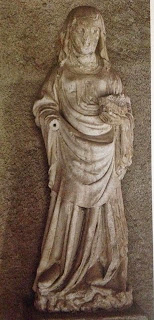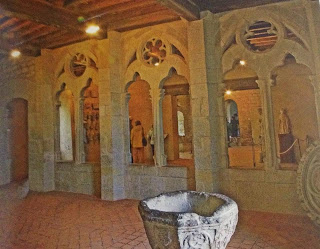Sahagun
Home of the rich and hansome religious houses and commercial centers
Insight from a Pilgrim...
My name is Becky Jennings. I am a fourth year music therapy major at Wartburg College in Waverly,IA. Many people begin their journey on the Pilgrimage to Santiago de Compostela for multiple reasons. Some of these reasons are simply a vacation, sight seeing, and educational; however some take this journey as an opportunity to explore themselves, rediscover their faith, and or search for the
deeper meaning and purpose of their life.
Personally, I began this journey with a view point of this trip being simply a trip out of the country within my college career. However as the year went on and I learned more about the Pilgrimage to Santiago de Compostela, I began to reflect more on what this trip really means to me. After reflecting, I decided to use this trip as, yes, a vacation, but also a time to let the trip's experiences lead me to the ultimate reason of why I wanted to take this trip. I am using this trip as a way to open myself up to new opportunities, new explorations of myself and my faith, but ultimately reflection and letting the moment speak to me and my need at that time.This trip has provided me ample time to explore and reflect on multiple moments at different levels. Furthermore, I have met a variety of individuals from different nationalities and backgrounds which has helped me on this journey of exploration.
The following information provided is background on Castrojeriz and its sights. Then I provided my reflection of what I saw at the bottom of this blog.
A History...
Sahagun's name came from the name San Facundo. San Facundo relates to one of the two 4th-c. martyrs that were buried near Rio Cea, which the tomb is marked by a Visigothic church. These two martyrs names are Saints Facundo and Primitivo. Furthermore, Sahagun's area is also the heart of a rich agricultural region that was a focal point of the wars between Muslims and Christians. Sahagun became a shelter for Mozarabic Christian Monks who were fleeing Muslim persecutions. In 987, Almanzor viewed Sahagun as a very valuable city, so he targeted the city and it ended up being destroyed. After Almanzor's death, the Christians viewed Sahagun as a priority to fix up. Because the Christians made Sahagun a priority, it became the most important Christian religious and economic center in Leon outside of the capital city. (Gitlitz & Davidson, 2000).
Image of statues of Saint Facundo and Saint Primitivo
Another important individual was also buried in this area. This important individual was King Alfonso VI. Not only was he educated in Sahagun, but he sought refuge here during the wars. During this time he met his third wife, but to get married he needed to get the marriage condoned. He invited the Benedictines of Cluny, which sent an abbot who condoned the marriage. However, Pope Gregory VII took the abbot out and sent a new abbot into the town, and with this new abbot the town became the center for Cluniac reform in the entire kingdom. Sahagun's growth was not only due to the important individuals who lived in the town but it was also due to the geography. Sahagun consisted of fertile rolling hills, cattle, grain, and river valleys nourished orchards and vineyards. The town was also divided based on what origin the citizens were. These origins included: Franks, Muslims, Jews, and old-time Christian residents of the kingdom of Leon. The population grew so much that more districts began to develop so 9 parishes were developed with their own Romanesque church, but only 4 remain today. Although the town was wealthy due to private donations to the monastery that supported the growth of Sahagun, the town slowly began to lose money once the shift in monastic power occurred. Due to the decline in money, Sahagun has become small and a market center without the monastery's former splendor. (Gitlitz & Davidson, 2000).
Image of close up map of Sahagun
In relation to the Pilgrimage, Sahagun was viewed as a major religious and commercial center that provided a variety of hospices for the pilgrims. The pilgrims who often stayed at Sahagun not only enjoyed the hospice opportunities, but they also appreciated and marveled over many of the monuments and religious establishments within the town. (Gitlitz & Davidson, 2000).
Below are some of the monuments and religious establishments that many of the pilgrims admired:
1) Monasterio de San Facundo
Almost nothing remains of this monastary. This monastary was one of the richest and most powerful monasteries in Iberia. For example, the orginal Roman construction over the tumbs of the martyrs Saints Facundo and Primitivo has vanish and so has the later Visigothic church. A building campaign began and in 1078 Ramundo de Borgona became the leader of the period of greatest construction. Because of this great cosntuction, the monastary became divided into four separate cloisters. Furthermore, San Facundo Monastary was Spain's most influencial monument in the Romanesque-Mudejar style. Although the monastary currently lies in ruins, many of the characteristics are seen in the ruins and churchs. Within the rest of the ruins, one will see a tower that currently serves the city as a clock tower. In addition, much of what has been left from the destruction of the monastary has been turned into private housing, a park, and a wide street. city. (Gitlitz & Davidson, 2000).
2) Arch of San Benito
This arch became the facade of the Monasterio de San Facundo's church. On this facade, it included two lions, a Hapsburg coat of arms, remnants of one Romanesque column, and round windows.
(Gitlitz & Davidson, 2000).
3) Iglesia de San Tirso
This is a Romanesque-Mudejar church built before 1123. It was built with the Romanesque mix of stone and brick. It includes a tower that has been rebuilt based on photographs due to it collasping in 1945. Inside of the church is the 13th-c. tomb tht is said to be one of Alfonso X's granddaughters. This tomb is placed in the center of the church and includes iconography of Christ in Majesty surrounded by the Tetramorphos. The angels suround the Agnus Dei and recieve the soul of the deseased woman.
(Gitlitz & Davidson, 2000).
4) Iglesia de San Lorenzo
The current building that is seen was built in the early 13th c. It has been said that many individuals sought refuge within this church. In fact one of these individuals was said to be shot by an arrow within the building due to the enemy shooting an arrow through the window. (Gitlitz & Davidson, 2000).
5) Convento de las Madres Benedictinas
This is a church in the early ogival style that has plain exterior. Also, the exterior has been completely rebuilt since it was orginally built. Inside of the church is a Museum of the Madres Benedictinas. In the museum is a small monstrance (custodia) that was built by Enrique de Arfe, who was an early Renaissance master goldsmith. At this church one will see delicate and flamboyant arches individual figures that are very exquisite and detailed. Attached to the church/museum, is a Baroque chapel that includes the churrigueresque retablo and the tombs of Alfonso VI and his four wives. (Gitlitz & Davidson, 2000).
6) Iglesia de San Juan de Sahagun
This church is in the Neoclassic style that includes a brightly painted facade that shows those of Andalucia. This church also holds the remains of Saint Facundo and Primitivo, and it also holds two alabaster retablos. (Gitlitz & Davidson, 2000).
7) Iglesia de La Trinidad
This church has been converted to a pilgrim hospice to house those who are apart of the Santiago Pilgrimage. (Gitlitz & Davidson, 2000).
8) Santuario de la Peregrina
In 1257, this church was created in the Gothic-Mudejar style. In fact, this church is all that remains of the Franciscan monastery that can be found on a bluff outside fo the town walls. The name of this church was created from a legend that states that pilgrims that came here would see a bright light and a woman with a glowing staff in her hand who came to guide them on their journey. On the ouside of the church, the brickwork is decorative, it includes horseshoe arches, and there are excavated foundation that has been uncovered from the monastery's former buildings. On the inside there is a 17th c. painting of the Virgin as Pilgrim by Luisa Roldan. Furthermore, there is a large painting that is located in the apse that commemorates the reconciliation in Rome between the Franciscan and Benedictine Orders. (Gitlitz & Davidson, 2000).
My Reflections:
Today we visited Sahagun for lunch. We ate at a cafe place that had lots of delicious food. At this cafe place, the bathrooms had sliding doors that had images of stick figures with wings; however, the woman's bathroom had devil horns with it. Many of the individuals including myself did not appreciate the woman representation at this eating place. Once we were done eating we tried to go to the Church of Saint Lucas, but it was closed for Siesta so we could not see right then. We waited until 4:30 P.M. to get in, but they still did not open. While waiting, many individuals sat and talked, read, journaled, and some even played a bit of soccer infront of the church. Outside of the church there were two black statues that looked to be apart of an offensive group, but we discovered that the statues individuals were not apart of that specific group, but rather they were wearing the sacs on their head as a form of penance. We did not get to see anything else in the town due to time and not much being their. However, it was a very relaxing experience and I did appreiciate going to the church to atleast see the outside.
References:
Gitlitz, D.M. & Davidson, L.K.(2000).
The pilgrimage road to santiago: the complete cultural handbook. New York, NY: St. Martin's Press, pg. 228-234.
Map of Sahagun: http://www.weather-forecast.com/locations/Sahagun-1Saints
Facundo and Primitivo:http://en.wikipedia.org/wiki/Facundus_and_Primitivus






























